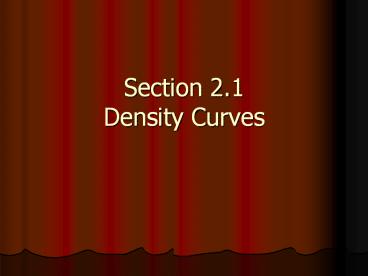Section 2.1 Density Curves PowerPoint PPT Presentation
1 / 20
Title: Section 2.1 Density Curves
1
Section 2.1Density Curves
2
- Get out a coin and flip it 5 times. Count how
many heads you get. - Repeat this trial 10 times.
- Create a histogram for your data (frequency of
how many heads you got in each of the 10 trials). - Put your histogram on the board.
3
Remember
- When we explore data on a single quantitative
variable - Plot your data (usually a histogram or stemplot)
- Look for the overall pattern (center, shape, and
spread) and for outliers - Calculate a numerical summary to describe center
(median or mean) and spread (IQR or standard
deviation)
4
From Histograms to Curves
- Sometimes, the overall pattern from a large
number of observations is so regular that we can
overlay a smooth curve.
5
Mathematical Models
- This curve is a mathematical model, or an
idealized description, for the distribution. - It is easier to work with the smooth curve than
with the histogram.
6
Density Curves
- Density curves are always positive (meaning its
always on or above the horizontal axis). - Areas under the curve represent proportions of
the observations. The area under a density curve
always equals 1. - The density curve describes the overall pattern
of a distribution. The area under the curve,
within a range of values, is the proportion of
all observations that fall in that range.
7
Quartiles
- How much area would be to the left of the first
quartile? - How much area would be to the right of the first
quartile? - How much area would be between the first and
third quartiles?
8
What Does All of This Mean?
- When a density curve is a geometric shape
(rectangle, trapezoid, or a combination of
shapes) we can use geometry to find areas. Those
areas help us find the median and the quartiles.
9
- Verify that the graph is a valid density curve.
- For each of the following, use areas under
density curve to find the proportion of
observations within the given interval. - 0.6ltXlt0.8
- 0ltXlt0.4
- 0ltXlt0.2
10
- The median of this density curve is a point
between X 0.2 and X 0.4. Explain why.
11
Im seeing Greek!
- In a distribution, mean is x-bar and the standard
deviation is s. - When looking at a density curve, the mean is µ
(pronounced mu) and the standard deviation is s
(pronounced sigma).
12
Normal Distributions
- Density curves have an area 1 and are always
positive. - Normal curves are a special type of density
curves. Normal curves are symmetrical density
curves. - T/F All density curves are normal curves.
- T/F All normal curves are density curves.
13
Characteristics of Normal Curves
- Symmetric
- Single-peaked (also called unimodal)
- Bell-shaped
µ
s
The mean, µ, is located at the center of the
curve. The standard deviation, s, is located at
the inflection points of the curve.
14
Parameters of the Normal Curve
- A normal curve is defined by its mean and
standard deviation. - Notation for a normal curve is N(µ, s).
15
Why Be Normal?
- Normal curves are good descriptions for lots of
real data SAT test scores, IQ, heights, length
of cockroaches (yum!). - Normal curves approximate random experiments,
like tossing a coin many times. - Not all data is normal (or even approximately
normal). Income data is skewed right.
16
The Empirical Rulea.k.a. 68-95-99.7 Rule
- All normal distributions follow this rule
- 68 of the observations are within one standard
deviation of the mean - 95 of the observations are within two standard
deviations of the mean - 99.7 of the observations are within three
standard deviations of the mean
17
Yay, Math!
- IQ scores on the WISC-IV are normally
distributed with a mean of 100 and a standard
deviation of 15. - Going up one s and down one s from 100 gives us
the range from 85 to 115. 68 of people have an
IQ between 85 and 115. - 95 of people have an IQ between ____ and ____.
- 99.7 of people have an IQ between ____ and ____.
18
Try This
- The heights of women aged 18 24 are
approximately normally distributed with a mean µ
64.5 inches and a standard deviation s 2.5
inches. - Between what two heights do the middle 95 fall?
- The tallest 2.5 of women are taller than what?
- What is the percentile for a woman who is 64.5
inches tall?
19
One more example
- The army reports that the distribution of head
circumference among male soldiers is
approximately normal with mean 22.8 inches and
standard deviation 1.1 inches. - What percent of soldiers have a head
circumference greater than 23.9 inches? - What percentile is this?
- What percent of soldiers have a head
circumference between 21.7 inches and 23.9 inches?
20
Homework
- Chapter 2 15a, 25, 41-45

